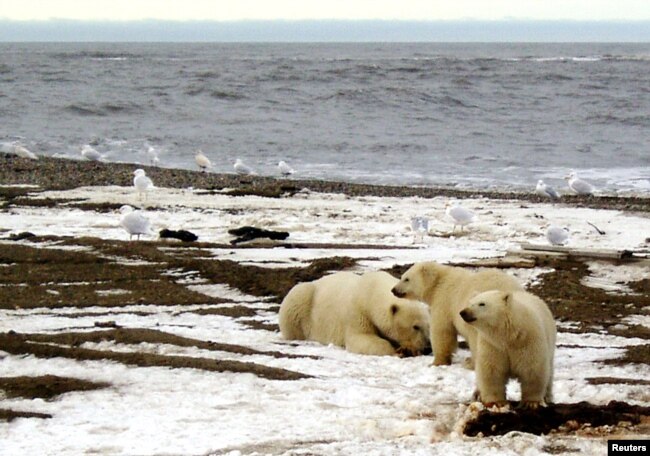Climate Change in Polar Regions' Bear Habitat
"This study was designed trying to get a much more detailed understanding of what the [Arctic polar] bears were actually doing on the ice."
"It allowed us to actually monitor the behaviour of the animals. [The camera] gave a perspective right underneath the bear's chin."
"Overall, the metabolic rates of these animals are similar to other marine and terrestrial carnivores. They need to be catching more seals than would have been predicted previously."
"It was quite fascinating and really exciting to watch."
"These animals are in extremely remote environments, where it’s typically impossible to observe individuals for a prolonged period of time.""We wanted to get a better understanding of just how many seals these bears needed to be catching to meet their energy demands, but also to get an understanding of their basic behaviors on the sea ice — how much time are they spending resting versus walking versus swimming, how much time they’re spending trying to hunt and catch seals, and how often they’re successful."
Anthony Pagano, researcher, University of California, Santa Cruz
 |
| A polar bear wears a GPS collar equipped with video camera on the sea ice of the Beaufort Sea. | Maria Spriggs, Busch Gardens |
"The beauty of this study I think really comes from the fact that it’s an all-in-one. The researchers have done it all in one, in one place, in a set of animals. That’s never been done before like this.""[Follow-up research should follow more animals over a longer stretch. But], I think it confirms all the reasons to be concerned about polar bears from a conservation perspective are intact."
"You might get a very different picture on weight gain from many more individuals [in a wider-ranging, longer-term study]."
Andrew Derocher, polar bear biologist, University of Alberta
/cdn.vox-cdn.com/uploads/chorus_asset/file/10137935/pagano4HR.jpg) |
Attaching cameras to polar bears is a latter-day innovation on the study of the habits of these beasts of the far North. A new study, to capture data on how often bears manage to secure seals for dinner and how many ideally would be required to keep them healthy in their very demanding environment was undertaken by Dr. Pagano and his colleagues who studied nine of the animals, in the Beaufort Sea.
The bears were fitted with GPS-enabled video cameras along with instruments designed to measure speed and distance travelled, and how efficiently and swiftly energy was burned, along with how much time the bears spent in the frigid waters of their environment. The study conclusions recently saw publication in the journal Science.
Spring represents the bears' prime hunting season. They require vast amounts of food, usually seals, to remain in good health. They consume over 12,000 kilocalories daily -- according to the new research findings -- considerably more than it was assumed by scientists up to now. As Arctic ice continues to melt, reflecting rising temperatures, polar bears, as suspected, may find their hunt compromised.
 |
| A polar bear sow and two cubs are seen on the Beaufort Sea coast within the 1002 Area of the Arctic National Wildlife Refuge in this undated handout photo provided by the U.S. Fish and Wildlife Service Alaska Image Library |
Over the course of a week on three successive Aprils from 2014 to 2016, the researchers gathered the data they would need to reach their conclusions. One of which is that the bears require considerably greater amounts of food than believed when scientists hypothesized that bears use little energy while waiting for a seal to come up through a blowhole. It was believed by many biologists that bears simply lowered their metabolism when there was little energy being expended.
What this study demonstrates is that those theories were incorrect. Bear metabolism, according to the study results, is 60 percent higher than believed through previous estimates. Bears require far more seals to maintain a healthy weight. Footage of bears catching seals and bringing them out of the ice, along with bears wrestling with large seals in frigid waters was captured by camera recordings of their activities.
In the final analysis, it was discovered by the researchers that five out of the nine bears in the study lost weight throughout the study period, representing up to ten percent of their body mass, despite the study's focus on the critical time when bears normally experience their most successful hunting of the year.
The population of polar beats in the Beaufort Sea has realized a decline in lock-step with declining sea ice. The study served a vital function in clarifying how polar bears manage to cope in the face of their habitat undergoing severe change, with the shrinking of sea ice.
 |
| In this April 15, 2015 photo provided by the United States Geological Survey, a polar bear wearing a GPS video-camera collar lies on a chunk of sea ice in the Beaufort Sea. A new study released Feb. 1, 2018 shows some polar bears in the Arctic are shedding pounds during the time they are supposed to be beefing up. |
"Polar bears may start to suffer from declining sea ice more rapidly than they would have, had their metabolism been lower as was previously mentioned."
Steven Amstrup, chief scientist, Polar Bears International
Labels: Arctic, Bioscience, Climate Change, Environment, Polar Bears

0 Comments:
Post a Comment
<< Home